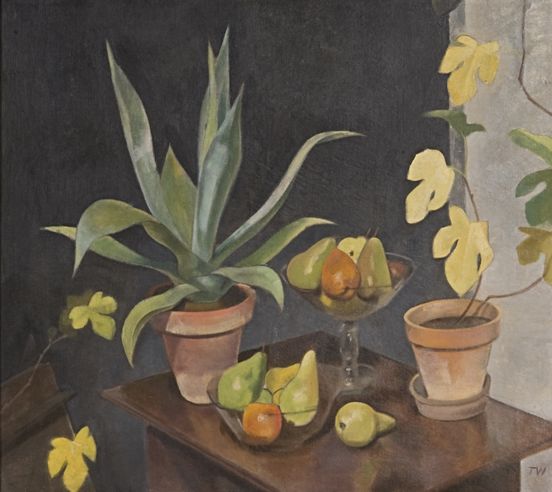| Genre | Painting |
| Materials | Oil on canvas |
| Size | 90 x 101 cm |
| Signature | bottom right: TW |
Restored with the support of the Ernst von Siemens Kunststiftung
Research status
Provenance is unclear and research continues.
A discarded portrait
The painting “Still Life with Fruit and Plants” was initially acquired from a private owner in 1962 for the Gallery of the 20th Century. That was an art collection founded in 1949 by the West Berlin Senate and it existed until 1968, when most of its holdings were integrated into the Neue Nationalgalerie. The State of Berlin transferred this work by Theodor Werner to the Berlinische Galerie in 1978.
Commenting on Werner’s early period from 1919 to 1929, the art historian Brigitte Lohkamp writes: “Almost all Werner’s surviving early œuvre is widely scattered between private owners across Swabia. Werner sold much of his work in those years. The unsold remainder was almost entirely destroyed in a fire shortly before the end of the Second World War.”
This suggests that the still life was sold before 1945, but its history of early owners is an open question. We still do not know whether the trail will lead to southern Germany, where Werner lived in the 1920s, or whether he sold the work somewhere else.
Perhaps the back of the painting holds a surprising clue. It contains a portrait in an advanced state of completion: a woman in a red dress sitting on a chair with her hands crossed.

The portrait on the back was effaced with a slovenly layer of white paint. Did the artist do that?
Theodor Werner, Stilleben mit Früchten und Pflanzen, c. 1923 (Back, Detail)
© Repro: Kai-Annett Becker
The portrait on the back is signed and dated, but we still do not know who the artist was.
Theodor Werner, Stilleben mit Früchten und Pflanzen, c. 1923 (Back, Detail)
© Repro: Kai-Annett BeckerThe signature with date confirms that the portrait was painted in March 1911, about 12 years before Werner’s work on the front. As the signature bears no resemblance to Theodor Werner’s, we can assume that the young artist lacked materials and so used the back of a painting by someone else for his “Still Life with Fruit and Plants” in the style of New Objectivity.
If we can establish the identity of the artist and sitter and the reason for discarding a fully worked portrait, this might guide us to the provenance of the still life – or it might lead us to a different story altogether.
